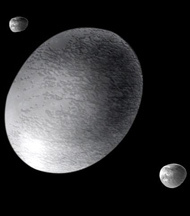
|
| ©NASA/ESA/HST |
| Computer model of 2003 EL61 and its two moons. |
Since 1992, astronomers have discovered well over a thousand bodies outside Neptune's orbit, in a region known as the Kuiper belt. Brown and his colleagues have found the largest Kuiper belt objects, including the dwarf planet Eris, which--at 2400 kilometers--is slightly larger than Pluto (ScienceNOW, 27 January 2006), and a strange object called 2003 EL61, which is about two-thirds Pluto's size. 2003 EL61 is shaped like a rugby ball because of its incredibly fast rotation of less than 4 hours. Moreover, it's as dense as basalt, suggesting it has lost most of its low-density icy mantle. These characteristics seemed to hint at a cataclysmic event in the dwarf planet's distant past: A cosmic collision could have broken up 2003 EL61's mantle, set it reeling, and produced the dwarf's two small moons.
Now, Brown and his colleagues have evidence. In this week's Nature, they report the discovery of five smaller Kuiper belt objects in orbits very similar to the elongated and slanted orbit of 2003 EL61, albeit in other parts of the solar system (see also Science, 27 October 2006, p. 590). Spectroscopic measurements with the 10-meter Keck II telescope at Mauna Kea, Hawaii, reveal that the five bodies (the largest of which is 400 kilometers across) have the same unusual surface properties as 2003 EL61: they all consist of nearly pure water ice crystals. Since the paper was accepted for publication, says Brown, two more fragments have been found. "The total number is probably up in the hundreds or even thousands," he says.
The find is "very unexpected," says theoretical dynamicist Harold Levison of the Southwest Research Institute in Boulder, Colorado. Even in its early days, when it must have been more populous, the Kuiper belt just didn't contain many large bodies. "The probability of such a collision taking place is almost zero," he says. Because Kuiper belt objects are the leftovers of the formation of the giant planets, the new find will certainly have implications for theories about the early evolution of the solar system, says Levison. For instance, he now believes that the colliding objects may originally have orbited in the so-called scattered disk--a large, distant population of ice dwarfs whose orbits were strongly perturbed by Neptune's gravity.
The bright pure-ice surface of 2003 EL61 and its siblings is also a mystery, says Brown. Given the orbital spread of the fragments, the collision must have taken place billions of years ago. But current wisdom says that icy surfaces turn dark and ruddy in less than 100 million years due to cosmic rays and micrometeoroid impacts in a process known as space weathering. Apparently, this never happened to 2003 EL61 and the smaller chunks. "This shows we don't understand space weathering at all," says Brown.



Reader Comments
to our Newsletter